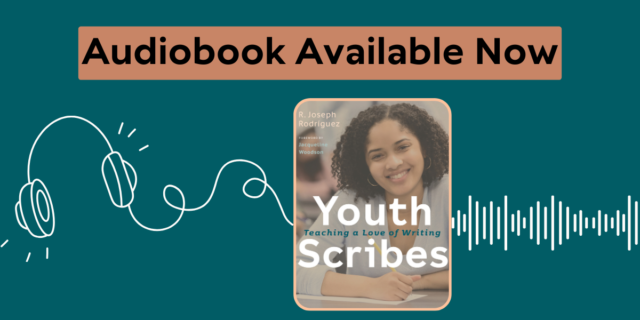
The following is an adapted excerpt from the forthcoming Youth Scribes by R. Joseph Rodríguez.
Our students as scribes can be guided by the invitation, idea, and wonder that they can write in our language arts classrooms. As Graves has explained, that invitation begins early in the lives of children. As teachers, we can sustain it through high school and beyond by connecting writing to our students’ diverse interests, literacies, and lives. Vivian Maria Vasquez encourages us to “think about what students are learning to read and write, what they do with that reading and writing, and what that reading and writing does to them and their world” (2014, 101).
Our own beliefs and knowledge as language arts teachers of diverse backgrounds and our stories about how we came to writing are significant to our students. Also, there are beliefs we abandoned over the years either because we felt they did not work or because students themselves spoke up against them. Some beliefs were challenged in our teaching preparation or later in our professional learning communities. As a result, our writing knowledge can take new directions in our lives and our students’ lives. As teacher scribes, we both shape and are shaped by our students.
As teachers, we possess the power to teach a love of writing in our students’ lives. Our habits and modeling can foster the strength and stamina our students require to cultivate writing throughout their lives. Writing is one scribal element of literacy—specific practices in becoming literate in a democratic society. Through a partial abecedarian listing (outlined below) I describe A Scribe’s Elements of Literacy, which are interconnected and interdependent for a scribal life—far from solely reading, writing, speaking, and listening. A Scribe’s Elements of Literacy come together in our deliberate lesson planning, delivery, feedback, and reflection that also cultivates the imagination and wonderment of our students.
A Scribe’s Elements of Literacy
- Imagining: Form a mental concept or picture of something in one’s mind.
- Justifying: Prove a point with evidence, facts, or reason.
- Knowing: Recall or retrieve cultural and prior knowledge for meaning.
- Listening: Engage with messaging, sounds, utterances, and spoken languages.
- Memorizing (metacognition): Apply prior and retained knowledge.
- Noticing: Pay attention to body language, cues, habits, messages, patterns, processes, relationships, and schemas.
- Observing: Identify audiences, practices, and visible information.
- Performing: Invite physical movement, responses, routines, and techniques.
- Questioning: Consider curiosity, exploration, and imagination.
- Reading: Interact with cultures, imagination, and languages for context, decoding, interpretation, and meaning across communities.
- Speaking: Communicate with oral-aural language and signing.
- Thinking: Monitor one’s thoughts to make them audible or visible.
- Understanding: Comprehend ideas for meaning and to gain awareness.
- Viewing: Interpret visual images, concepts, and content.
- Writing (wonderment): Compose artifacts and ideas with characters, languages, letters, logograms, symbols, and text in digital and nondigital modes by noting occasion, valuing ideas, and expressing wonder.
Scribal Practices
Every student is a scribe who can enact A Scribe’s Elements of Literacy with interest, joy, and wonder, while guided by teachers toward scribal inquiry in the literacy journey. Each one of these incorporates the Universal Design for Learning, which considers how students engage with the lesson and content, how information is presented to students, and how students are expected to take action and express themselves.
The abecedarian form is meant to demonstrate how scribes put the elements of literacy into practice in deep and profound actions. For instance, imagining invites a person’s own mental picture or concept about an idea or topic. Justifying requires evidence to make a reasoned point or appeal. Knowing is the act of recalling not just prior or background knowledge, but also cultural knowledge. Listening requires not just hearing but engaging with messages, sounds, utterances, and spoken languages. Although memorizing can easily fall into a rote practice, it is necessary to apply prior and retained knowledge, such as number sense, and to recall specific sentence structure and writing practices for meaningful and actionable learning. As we move through our environment, noticing is enacted each time we pay attention to the body language of ourselves and others and also to the cues, habits, messages, patterns, processes, relationships, and schemas in communication. Observing unfolds when we identify audience, practices, and visible information. Performing occurs regularly and often as we invite practices that are essential in the performing arts: physical movements, responses, routines, and techniques. Questioning is undertaken by the scribe who puts into practice curiosity, exploration, and imagination to look deeper than surface level. Reading requires interacting with various cultures, imaginations, and languages through context, cues, decoding, interpretation, meaning, and signals across communities. Speaking takes form as we communicate using oral-aural language and signing. Thinking is enacted while monitoring one’s thoughts in order to make them audible or visible. Understanding is shown when we comprehend ideas for meaning and to gain awareness. Viewing unfolds at mass speeds as we interpret visual images, concepts, and content. And finally, writing requires composing artifacts and ideas with characters, languages, letters, logograms, symbols, and texts in digital and nondigital modes by noting occasion, valuing ideas, and expressing wonderment.
Overall, our practice and the impressions we impart upon our students about a scribal life can become fulfilling and thrilling as they put A Scribe’s Elements of Literacy into practice. As a teacher, I am responsible for the writing beliefs I impart on students, and both I and my students need to understand our scribal roles.
***



